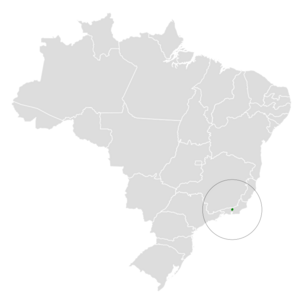Rio de Janeiro antwren facts for kids
Quick facts for kids Rio de Janeiro antwren |
|
|---|---|
| Scientific classification | |
| Genus: |
Myrmotherula
|
| Species: |
fluminensis
|
 |
|
| Synonyms | |
|
Myrmotherula luctuosa |
|
The Rio de Janeiro antwren (Myrmotherula fluminensis) is a small bird found only in Brazil. It belongs to a group of birds called "typical antbirds." This bird is quite rare, and scientists are still learning about it.
Contents
A Bird Mystery
The Rio de Janeiro antwren is a bit of a puzzle for scientists. It was first discovered in 1988. Some bird experts think it is its own unique species. However, others believe it might be a special color form of another bird called the silvery-flanked antwren. Some even wonder if it's a mix, or "hybrid," of two different antwren species. The person who first found the bird, Gonzaga, thought all these ideas were possible.
What Does It Look Like?
The Rio de Janeiro antwren is about 10 cm (3.9 in) long. That's about the length of a small pencil! The one bird that was studied closely weighed about 9 g (0.32 oz).
The male antwren has a whitish ring around its eye and a white stripe just below it. Its upper body is gray. Its wings are a darker gray, with black feathers that have white tips. Its tail is also gray. The throat, chest, and the middle of its belly are black. The rest of its underside is gray, matching its upper body. It has brown eyes, a dark brownish-black beak, and pale bluish-gray feet with yellowish bottoms.
Scientists have not yet described what the female Rio de Janeiro antwren looks like.
Where Does It Live?
The first Rio de Janeiro antwren was found in 1988 in the central part of Rio de Janeiro state in Brazil. After that, it wasn't seen again at that exact spot.
However, since 1994, it has been spotted a few times in a special nature area called Reserva Ecológica Guapiaçu (REGUA). This area is close to where the first bird was found. The first bird was in a small, disturbed forest near the sea. The birds seen at REGUA have been in younger forests, less than 25 years old. These sightings were near old clearings and at elevations between 35 and 200 m (100 and 700 ft) above sea level.
Behavior
Movement
Scientists don't know much about how the Rio de Janeiro antwren moves around. The first bird was found in an area that had been studied for many years. This made some experts wonder if the bird might have just wandered into the area or moved down from higher mountains nearby.
Feeding
We know very little about what the Rio de Janeiro antwren eats. The stomach of the first bird found contained parts of arthropods, which are like insects and spiders. These birds have been seen feeding with groups of different bird species. They usually look for food close to the ground, often within about 2 m (7 ft) of the forest floor.
Reproduction
Nothing is known about how the Rio de Janeiro antwren reproduces or raises its young.
Vocalization
As of early 2024, there are no public recordings of the Rio de Janeiro antwren's calls. However, some scientists have heard them. They say the bird's calls are almost exactly like those of the silvery-flanked antwren.
Status
The IUCN (International Union for Conservation of Nature) is a group that checks if animals are endangered. They follow the idea that the Rio de Janeiro antwren is just a color form of the silvery-flanked antwren. Because of this, they have not studied the Rio de Janeiro antwren as a separate species to see if it needs protection.

